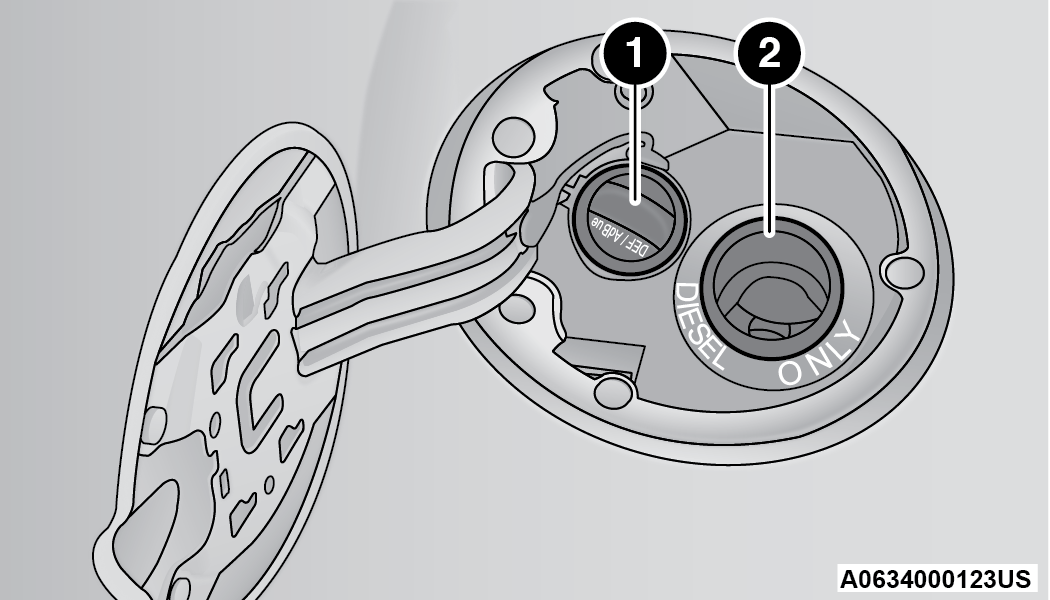For the correct fluid type ENGINE FLUIDS AND LUBRICANTS.
Remove cap from DEF tank (located on drivers side of the vehicle or in fuel door).

Fill Locations
| 1 — Diesel Exhaust Fluid (DEF) Fill Location |
| 2 — Diesel Fuel Fill Location |
-
The DEF gauge may take up to five seconds to update after adding a gallon or more of DEF to the DEF tank. If you have a fault related to the DEF system, the gauge may not update to the new level. See an authorized dealer for service.
-
The DEF gauge may also not immediately update after a refill if the temperature of the DEF fluid is below 12°F (-11°C). The DEF tank heater will possibly warm up the DEF fluid and allow the gauge to update after a period of run time. Under very cold conditions, it is possible that the gauge may not reflect the new fill level for several drives.
-
At 40°F (4°C) you could see some increase in the DEF gauge due to the tank thawing. The gauge and level sensor are working properly and are just updating with proper thawed DEF.
-
Excessive overfilling of the DEF tank can result in a MIL lamp/fault code and inaccurate level readings.
Refilling With Nozzles
You can fill up at any DEF distributor.
Proceed as follows:
-
Insert the DEF nozzle in the filler tube, start refilling and stop refilling at the first shut-off (the shut-off indicates that the DEF tank is full). DO NOT proceed with the refilling, to prevent spillage of DEF.
-
Extract the nozzle.
Refilling With Containers
Proceed as follows:
-
Check the expiration date.
-
Read the advice for use on the label before pouring the content of the bottle into the DEF tank.
-
After the indication appears on the instrument cluster display INSTRUMENT CLUSTER DISPLAY fill the DEF tank with no more than 4 gallons (15 liters).
-
To avoid DEF spillage, and possible damage to the DEF tank from overfilling, do not “top off” the DEF tank after filling.
-
DO NOT OVERFILL. DEF will freeze below 12ºF (-11ºC). The DEF system is designed to work in temperatures below the DEF freezing point, however, if the tank is overfilled and freezes, the system could be damaged.
-
When DEF is spilled, clean the area immediately with water and use an absorbent material to soak up the spills on the ground.
-
Do not attempt to start your engine if DEF is accidentally added to the diesel fuel tank as it can result in severe damage to your engine, including but not limited to failure of the fuel pump and injectors.
-
Never add anything other than DEF to the tank – especially any form of hydrocarbon such as diesel fuel, fuel system additives, gasoline, or any other petroleum-based product. Even a very small amount of these, less than 100 parts per million or less than 1 oz. per 78 gallons (295 liters) will contaminate the entire DEF system and will require replacement. If owners use a container, funnel or nozzle when refilling the tank, it should either be new or one that has only been used for adding DEF. Mopar® provides an attachable nozzle with its DEF for this purpose.
Stop filling the DEF tank immediately if DEF splashes or wells back in the filler neck.
Reinstall cap onto DEF filler tube.
Filling The Def Tank In Cold Climates
Since DEF will begin to freeze at 12°F (-11°C), your vehicle is equipped with an automatic DEF heating system. This allows the DEF injection system to operate properly at temperatures below 12°F (-11°C). If your vehicle is not in operation for an extended period of time with temperatures below 12°F (-11°C), the DEF in the tank may freeze. If the tank is overfilled and freezes, it could be damaged. Therefore, do not overfill the DEF tank.
Extra care should be taken when filling with portable containers to avoid overfilling. Note the level of the DEF gauge in your instrument cluster. You may safely add a maximum of 2 gallons (7.5 liters) of DEF from portable containers when your DEF gauge is reading ½ full.